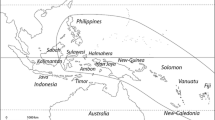Abstract
Material of 229 clones of ulluco (Ullucus tuberosus), representing 10 accessions from markets in southern Peru and one from the wild in Bolivia, was analyzed with regard to morphological variation. The diploid chromosome number (2n = 24) was ascertained in 16 of the clones. Clones grown in different environments (e.g., long vs. short day) retained a more or less similar order of variation with respect to color of the tubers, stems, and leaves and the length/width ratio of the leaves. The shape of fully developed tubers also showed stable variation. Within a single experiment several other vegetative characters showed significant differences between accessions. Furthermore, many flower and inflorescence characters showed variation between accessions, some of them also indicating geographical variation between the Puno-Juliaca area and the Cuzco area. Considerable variation between the clones of an accession was evident, some accessions being clearly more variable than others. Our results show that ulluco is a crop plant that varies extensively even within a geographically limited area. Although repeatedly referred to in the literature as a purely asexual crop, ulluco was shown to be capable of sexual reproduction; this must have been and possibly still is an important source of genetic variation in the species.
Similar content being viewed by others
Literature Cited
Arbizu, C, and J. Valladolid. 1982. Lista de descriptores para el ulluco. Pages 335–344in III Congreso International de Cultivos Andinos. La Paz, Bolivia.
Brücher, H. 1967.Ullucus aborigineus spec, nov., die Wildform einer andinen Kulturpflanze. Ber. Deutsch. Bot. Ges. 80:376–381.
— 1977. Tropische Nutzpflanzen. Springer-Verlag, Berlin.
Brush, S. B., H. J. Carney, and Z. Huaman. 1981. Dynamics of Andean potato agriculture. Econ. Bot. 35:70–88.
Bukasov, S. M. 1930. The cultivated plants of Mexico, Guatemala and Colombia. Bull. Appl. Bot. PL-Breed. Suppl. 47: 1–553.
Campana, A., and L. Quispe. 1986. Recolección, mantenimiento y evaluación de tubérculos andinos (oca, olluco y mashua) en el valle del Mantaro. Page 202in Anales V Congreso International de Sistemas Agropecuarios Andinos. Puno, Peru.
Canaza, D., and A. Callohuanca. 1986. Evaluación de germoplasma de olluco en el Centro Experimental Camacani. Page 201in Anales V Congreso International de Sistemas Agropecuarios Andinos. Puno, Peru.
Cardenas, M. 1969. Manual de plantas economicas de Bolivia. Icthus, Cochabamba, Bolivia.
—, and J. G. Hawkes. 1948. Numero de cromosomas de algunas plantas nativas cultivadas por los indios en los Andes. Revista Agric. (Cochabamba) 5:30–32.
Dixon, W. J., ed. 1985. BMDP statistical software manual. Univ. Calif. Press, Berkeley.
Escobar, M., and R. Ibáñez. 1986. Efecto de niveles de N-P-K en el rendimiento de olluco(Ullucus tuberosus Loz) en condiciones de Allpachaca. Page 204in Anales V Congreso International de Sistemas Agropecuarios Andinos. Puno, Peru
Galwey, N. W., and J. Risi Carbone. 1983. Grain and tuber collecting in the Andes. PI. Genet. Resources Newslett. 55:17–20.
Herquinio, F., L. Toribio, F. Roman, and A. Muñoz. 1986. Informe de investigación 1984–85,1985–86. Univ. Nac. del Centro del Peru, El Mantaro.
Herrera, F. L. 1942. Plantas endémicas domesticadas por los antiguos peruanos. Rev. Mus. Nac. 11:25–30.
Hodge, W. H. 1951. Three native tuber foods of the high Andes. Econ. Bot. 5:185–201.
Jackson, M. T., J. G. Hawkes, and P. R. Rowe. 1980. An ethnobotanical field study of primitive potato varieties in Peru. Euphytica 29:107–113.
James, P. E. 1942. Latin America. The Odyssey Press, New York.
Jiménez, L. A. 1986. Tres modalidades de siembra en cultivo asociado oca-olluco. Pages 207–211in Anales V Congreso International de Sistemas Agropecuarios Andinos. Puno, Peru
Jokela, P., and L. Pietilä. 1988. Collecting minor tuber crops in the Andes. PI. Gen. Resources Newslett. 72:37.
Kalliola, R., P. Jokela, L. Pietilä, A. Rousi, J. Salo, and M. Yli-Rekola. n.d. Influencia del largo fotoperiodo en el crecimiento y formation de los tubérculos de ulluco(Ullucus tuberosus, Basellaceae), oca (Oxalis tuberosa, Oxalidaceae) y afñu (Tropaeolum tuberosum, Tropaeolaceae). Turrialba, Costa Rica. (In press)
Kay, D. E. 1973. Root crops. Tropical Products Institute, London.
Leñn, J. 1964. Plantas alimenticias andinas. Inst. Interamer. Cienc. Agric. Zona And., Lima, Peru.
Mabry, T. J. 1976. Pigment dichotomy and DNA-RNA hybridization data for centrospermous families. PI. Syst. Evol. 126: 79–94.
Moquin-Tandon, A. 1849. Basellaceae. Pages 220–230in A. P. de Candolle, Prodromus systematis naturalis regni vegetabilis 13:2.
Morren, C. 1852. L'ulluco, l’ullucus, le melloco, le melloca. Belgique Hort. 2:305–308.
Pietilä, L. 1986. Eri alkuperää olevien ulluco-kantojen(Ullucus tuberosus) reagointi pitkään ja lyhyeen päivään. Unpublished thesis. Department of Biology, University of Turku, Finland.
Pietilä, L., and P. Jokela. 1988. Cultivation of minor tuber crops in Peru and Bolivia. J. Agric. Sci. Finland 60:87–92.
Puro, J., and S. Nokkala. 1977. Meiotic segregation of chromosomes inDrosophila melanogaster oocytes, a cytological approach. Chromosoma 63:273–286.
Revilla, J. L. 1983. Conservatión de productos agricolas en el campo. Minka 10:20–24.
Rousi, A., J. Salo, R. Kalliola, P. Jokela, L. Pietilä, and M. Yli-Rekola. 1986. Variation pattern in ulluco(Ullucus tuberosus-Basellaceae), a supposedly asexual Andean tuber crop. Acta Hort. 182:145–152.
—, M. Yli-Rekola, P. Jokela, R. Kalliola, L. Pietilä, and J. Salo. 1988. The fruit ofUllucus (Basellaceae), an old enigma. Taxon 37:71–75.
Sodoffsky, W. 1851. Ueber denUllucus tuberosus Lozano. Bull. Soc. Imp. Naturalistes Moscou 24: 512–518.
Valladolid, J., B. Del Aguila, P. Palomino, Z. Ochoa, and V. Palomino. 1982. Análisis de crecimiento de tres especies de plantas tuberosas andinas bajo condiciones de cultivo de secano en Allpachaca,
Ayacucho. Pages 377–389in III Congreso International de Cultivos Andinos. La Paz, Bolivia.
Vilmorin, L. 1848. The melloco. Gard. Chron. 51:828.
Zúóiga, N. 1986. Técnicas de multiplicación acelerada en tuberosas andinas. Pages 202–203in Anales V Congreso International de Sistemas Agropecuarios Andinos. Puno, Peru.
Author information
Authors and Affiliations
Rights and permissions
About this article
Cite this article
Rousi, A., Jokela, P., Kalliola, R. et al. Morphological variation among clones of ulluco (Ullucus tuberosus, Basellaceae) collected in Southern Peru. Econ Bot 43, 58–72 (1989). https://doi.org/10.1007/BF02859325
Received:
Accepted:
Issue Date:
DOI: https://doi.org/10.1007/BF02859325




